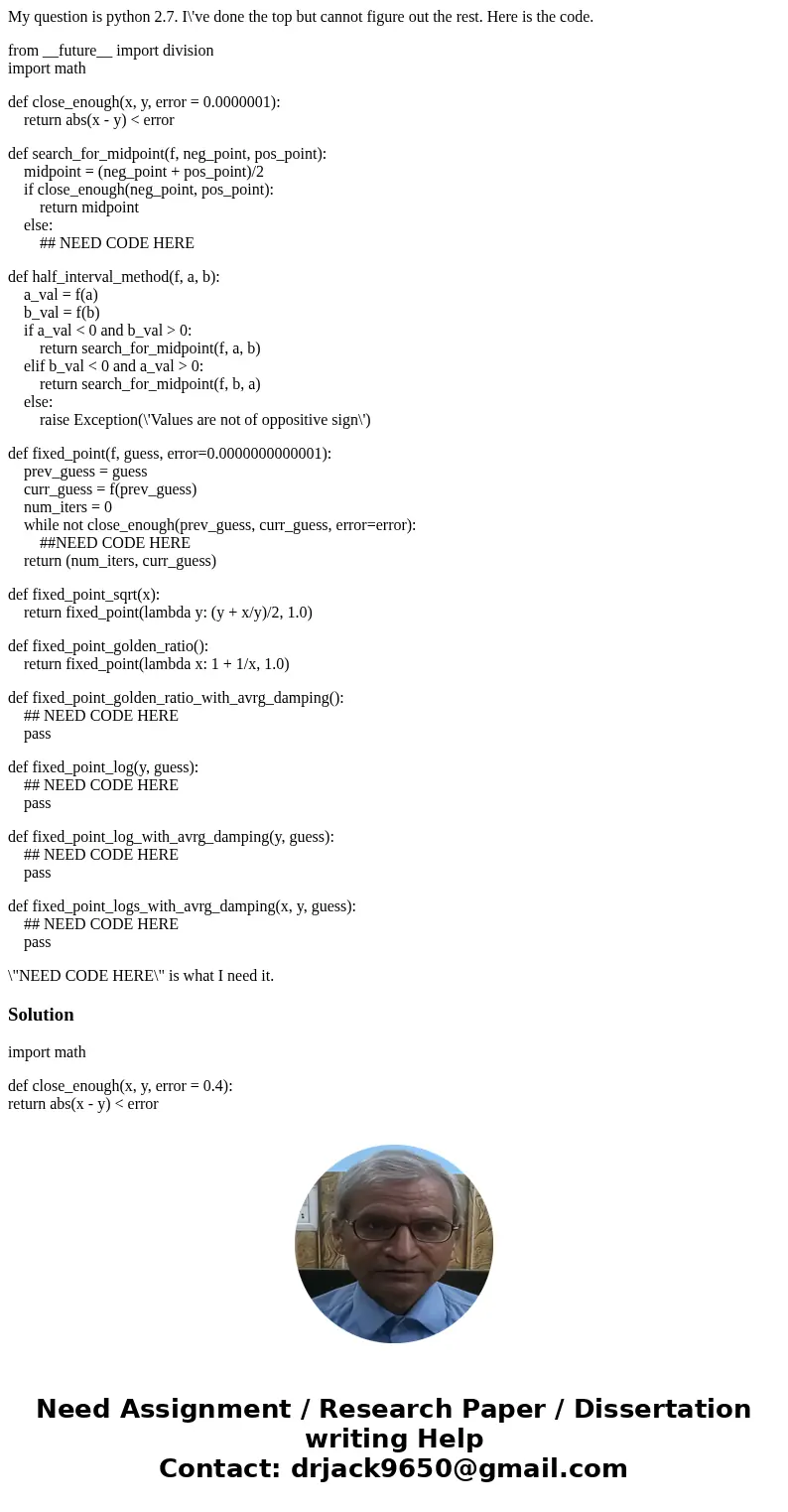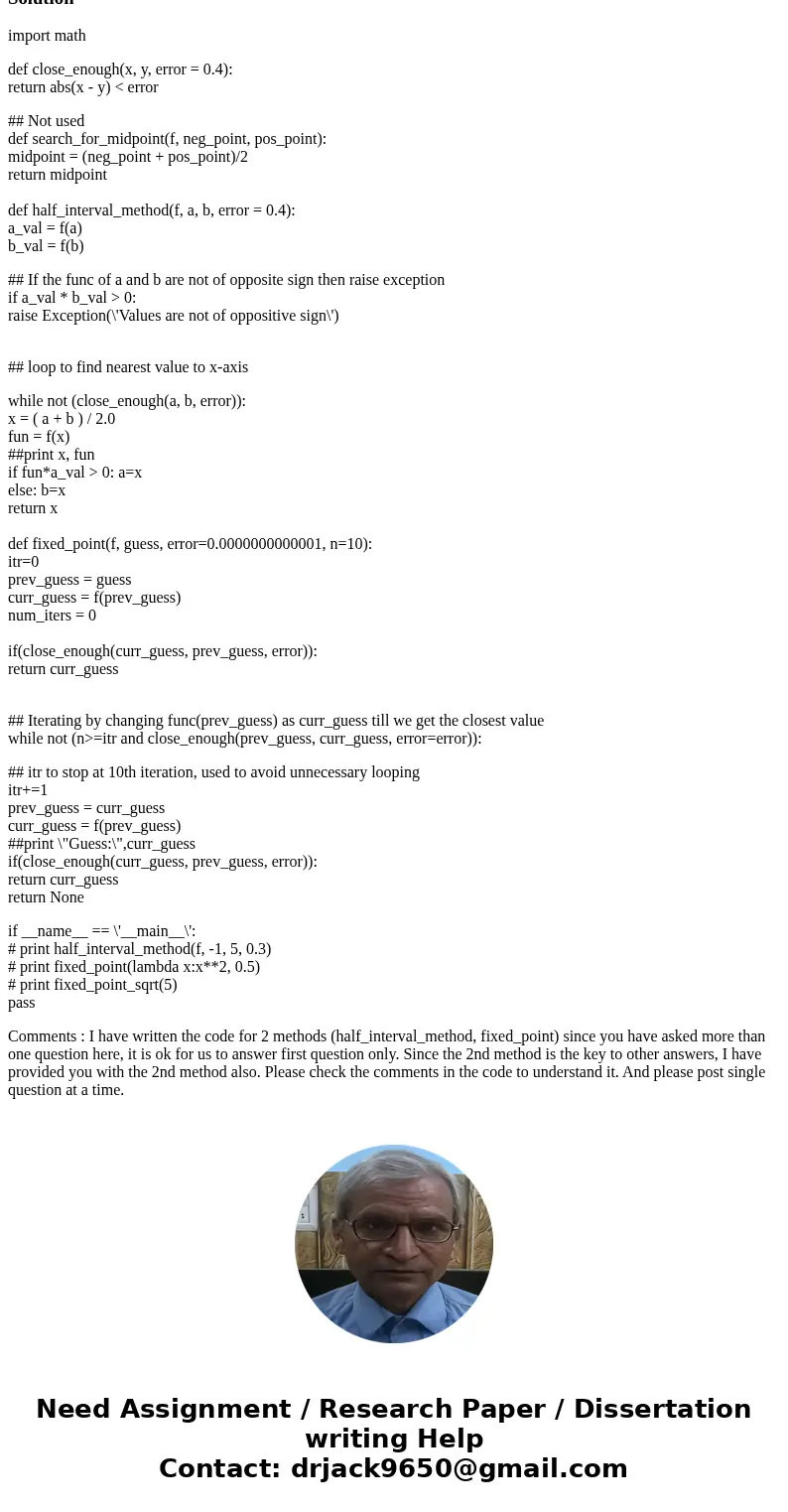My question is python 27 Ive done the top but cannot figure
My question is python 2.7. I\'ve done the top but cannot figure out the rest. Here is the code.
from __future__ import division
import math
def close_enough(x, y, error = 0.0000001):
return abs(x - y) < error
def search_for_midpoint(f, neg_point, pos_point):
midpoint = (neg_point + pos_point)/2
if close_enough(neg_point, pos_point):
return midpoint
else:
## NEED CODE HERE
def half_interval_method(f, a, b):
a_val = f(a)
b_val = f(b)
if a_val < 0 and b_val > 0:
return search_for_midpoint(f, a, b)
elif b_val < 0 and a_val > 0:
return search_for_midpoint(f, b, a)
else:
raise Exception(\'Values are not of oppositive sign\')
def fixed_point(f, guess, error=0.0000000000001):
prev_guess = guess
curr_guess = f(prev_guess)
num_iters = 0
while not close_enough(prev_guess, curr_guess, error=error):
##NEED CODE HERE
return (num_iters, curr_guess)
def fixed_point_sqrt(x):
return fixed_point(lambda y: (y + x/y)/2, 1.0)
def fixed_point_golden_ratio():
return fixed_point(lambda x: 1 + 1/x, 1.0)
def fixed_point_golden_ratio_with_avrg_damping():
## NEED CODE HERE
pass
def fixed_point_log(y, guess):
## NEED CODE HERE
pass
def fixed_point_log_with_avrg_damping(y, guess):
## NEED CODE HERE
pass
def fixed_point_logs_with_avrg_damping(x, y, guess):
## NEED CODE HERE
pass
\"NEED CODE HERE\" is what I need it.
Solution
import math
def close_enough(x, y, error = 0.4):
return abs(x - y) < error
## Not used
def search_for_midpoint(f, neg_point, pos_point):
midpoint = (neg_point + pos_point)/2
return midpoint
def half_interval_method(f, a, b, error = 0.4):
a_val = f(a)
b_val = f(b)
## If the func of a and b are not of opposite sign then raise exception
if a_val * b_val > 0:
raise Exception(\'Values are not of oppositive sign\')
## loop to find nearest value to x-axis
while not (close_enough(a, b, error)):
x = ( a + b ) / 2.0
fun = f(x)
##print x, fun
if fun*a_val > 0: a=x
else: b=x
return x
def fixed_point(f, guess, error=0.0000000000001, n=10):
itr=0
prev_guess = guess
curr_guess = f(prev_guess)
num_iters = 0
if(close_enough(curr_guess, prev_guess, error)):
return curr_guess
## Iterating by changing func(prev_guess) as curr_guess till we get the closest value
while not (n>=itr and close_enough(prev_guess, curr_guess, error=error)):
## itr to stop at 10th iteration, used to avoid unnecessary looping
itr+=1
prev_guess = curr_guess
curr_guess = f(prev_guess)
##print \"Guess:\",curr_guess
if(close_enough(curr_guess, prev_guess, error)):
return curr_guess
return None
if __name__ == \'__main__\':
# print half_interval_method(f, -1, 5, 0.3)
# print fixed_point(lambda x:x**2, 0.5)
# print fixed_point_sqrt(5)
pass
Comments : I have written the code for 2 methods (half_interval_method, fixed_point) since you have asked more than one question here, it is ok for us to answer first question only. Since the 2nd method is the key to other answers, I have provided you with the 2nd method also. Please check the comments in the code to understand it. And please post single question at a time.


 Homework Sourse
Homework Sourse